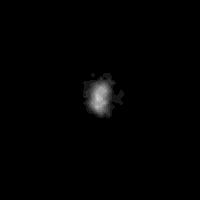Nereid (moon) facts for kids
 |
|
| Discovery | |
|---|---|
| Discovered by | Gerard P. Kuiper |
| Discovery date | May 1, 1949 |
| Orbital characteristics | |
| Periapsis | 1,353,600 km (0.00905 AU) |
| Apoapsis | 9,623,700 km (0.06433 AU) |
| 5,513,400 km (0.03685 AU) | |
| Eccentricity | 0.7512 |
| 360.1362 d | |
|
Average orbital speed
|
1.12 km/s |
| Inclination | 5.07° (to Ecliptic) 32.55° (to Neptune's equator) 7.232° (to the local Laplace plane) |
| Satellite of | Neptune |
| Physical characteristics | |
|
Mean radius
|
170 km |
| Mass | 3.1×1019 kg |
|
Mean density
|
1.5 g/cm3 |
| 0.48 d (11 h 31 min) | |
| Albedo | 0.14 |
| Temperature | ~51 K mean (estimate) |
Nereid, also known as Neptune II, is one of the many moons that orbit the planet Neptune.
Discovery of Nereid
Nereid was found on May 1, 1949. It was discovered by a scientist named Gerard Kuiper. He was also the one who suggested its name.
The moon is named after the Nereids. In Greek mythology, Nereids are beautiful sea-nymphs.
Nereid's Unusual Orbit
For a long time, Nereid was the farthest known moon from Neptune. Now, other moons like Halimede and Neso are known to be even farther away. Nereid is the third largest moon of Neptune. It has a diameter of about 340 kilometers.
Nereid has a very unusual and stretched-out orbit. Its average distance from Neptune is about 5,513,400 kilometers. However, because its orbit is so eccentric (not a perfect circle), its distance changes a lot. It can be as close as 1,353,600 kilometers to Neptune or as far as 9,623,700 kilometers.
For many years, Nereid had the most eccentric orbit of any known moon in our Solar System. More recently, a moon of Saturn called Bestla was found to have an even more eccentric orbit.
Scientists think Nereid's strange orbit might mean it was once an asteroid or a Kuiper belt object that Neptune's gravity captured. Another idea is that its orbit was changed when Neptune's largest moon, Triton, was captured. We still don't know much else about Nereid.
What Voyager 2 Saw
The Voyager 2 space probe flew past Neptune in 1989. However, Nereid was too far away for the probe to get clear pictures of it.
The photos that Voyager 2 sent back only showed that Nereid is not perfectly round. It has an irregular shape. The pictures were not clear enough to show any details on its surface.
See also
 In Spanish: Nereida (satélite) para niños
In Spanish: Nereida (satélite) para niños

